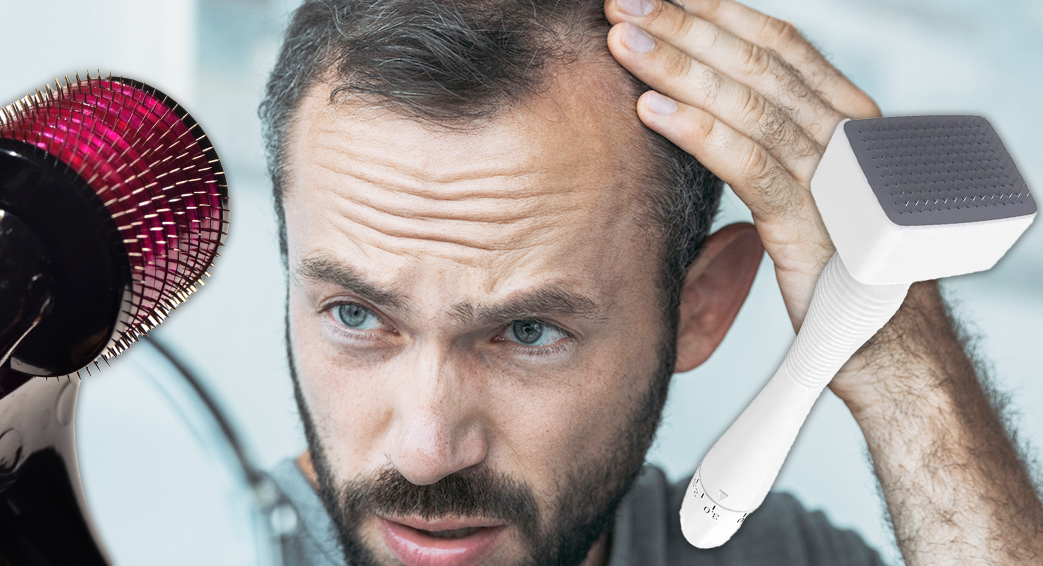In the hair loss treatment industry, new trends frequently emerge, promising seemingly simple at-home solutions to the complex issue of common male and female pattern hair loss. One of the latest viral trends involves derma rolling or derma stamping, followed by the application of oils or minoxidil on abraded skin. While these practices may seem promising, especially with the instant gratification of viral popularity and influencer endorsements, there is very little clinical evidence to support their long-term benefits. In fact, the risks may far outweigh any potential gains for those hoping to restore their hair.
It’s important to note that the concept of abrading the scalp is not new. For decades, marketers of hair loss products, and even some undereducated physicians, have promoted various methods of scalp abrasion—often with little to no evidence backing their effectiveness. These practices, though continually repackaged, carry risks that often outweigh any short-term cosmetic benefits.
Short-Term Results, Long-Term Harm
Some individuals who try derma rolling or stamping may experience short-term improvements, such as a temporary increase in hair thickness or the appearance of new growth. However, these initial results are often fleeting, and over time, the negative effects—such as micro-scarring, collagen disruption, and long-term scalp damage—begin to outweigh any perceived benefits. What may seem like progress early on can quickly lead to further hair loss and a compromised scalp environment in the long run.
Board-Certified Dermatologists Fueling the Trend
A concerning aspect of this trend is the role that even board-certified dermatologists—trusted professionals in the hair loss space—are playing in promoting derma rolling and derma stamping. In their bid to gain visibility as social media influencers, many of these dermatologists promote these unproven treatments to capture attention and followers. Unfortunately, their endorsements often rely on the words of product salespeople or questionable studies, rather than on solid clinical evidence. This lends undue credibility to a practice that could potentially harm those seeking solutions for hair loss.
The Hidden Dangers of Micro-Scarring and Collagen Disruption
One of the most concerning aspects of derma rolling is its potential to cause micro-scarring on the scalp. Repeatedly abrading the skin with needles can trigger excessive collagen formation, leading to fibrosis—thickening and scarring of the tissue. This scarring impairs the scalp’s ability to support healthy hair follicles and can block hair regrowth altogether. While collagen production can be stimulated by procedures like derma rolling, it naturally decreases as we age, and overstimulating collagen formation can lead to unintended consequences. The idea that more collagen is always better is a dangerous misconception. Excessive collagen formation can cause scarring, which not only prevents healthy hair regrowth but can cause irreversible damage to the scalp, ultimately worsening hair loss.
Manipulating the body’s collagen production without medical oversight is neither sustainable nor safe for treating hair loss. This approach can harm the scalp, making it a poor environment for hair restoration over the long term.
The Dangers of Combining Derma Rolling with Minoxidil
Minoxidil, one of the only FDA-approved treatments for hair loss, is a widely used topical solution. However, applying it to abraded skin after derma rolling can cause more harm than good—especially when formulations containing SD alcohol are involved. The alcohol in these products can damage the delicate tissue of the scalp, especially when applied to already compromised skin, leading to irritation, cell death, and further damage to the scalp’s overall health. This combination significantly increases the risk of infection, inflammation, and permanent scarring, creating a poor environment for hair regrowth.
Derma Rolling Can Disrupt Natural Hair Growth Cycles
Derma rolling not only affects the skin but also poses risks to the existing hair follicles in the scalp. While the needles do not typically penetrate deeply enough to displace hair follicles, the manual act of rolling can pull out hair from the roots, which disrupts the natural hair growth cycle. This disruption can cause premature shedding and give the appearance of thinning hair. Over time, if derma rolling is done excessively or improperly, this repeated disturbance to the hair cycle can contribute to long-term thinning and hair loss, rather than promoting regrowth.
Additionally, using minoxidil prematurely—especially in individuals whose hair loss has not stabilized—can further exacerbate shedding and heighten anxiety over hair thinning. The combination of these treatments can make hair appear thinner and extend shedding phases, ultimately causing more harm than good for those seeking to improve hair density.
Counterproductive Practices That Damage the Scalp Long-Term
In the pursuit of seemingly quick fixes, individuals unknowingly risk causing long-term damage to their scalp. Microneedling is a medical procedure that should be performed by trained professionals, yet its do-it-yourself version has gained alarming popularity. The risks of combining derma rolling with unverified treatments like oils or improperly applied minoxidil outweigh any potential benefits. Instead of promoting hair growth, these methods can lead to chronic inflammation, scarring, and a significant worsening of hair loss.
Conclusion: Proceed with Caution
At present, there is not enough clinical evidence to endorse derma rolling or derma stamping as safe, effective long-term treatments for hair loss. While some individuals may see short-term improvements, these results often fade, and the negative consequences become more pronounced. The potential for micro-scarring, disruption of collagen formation, and long-term damage to the scalp should not be ignored. Combining these practices with products like minoxidil can further harm an already compromised scalp.
For those seeking effective hair loss solutions, it is crucial to consult a qualified medical professional and rely on evidence-based treatments. Viral trends and quick fixes may seem appealing, but they often come at the cost of your long-term scalp health. Prioritize proven, medically sound options over the latest social media fads, and always proceed with caution.
